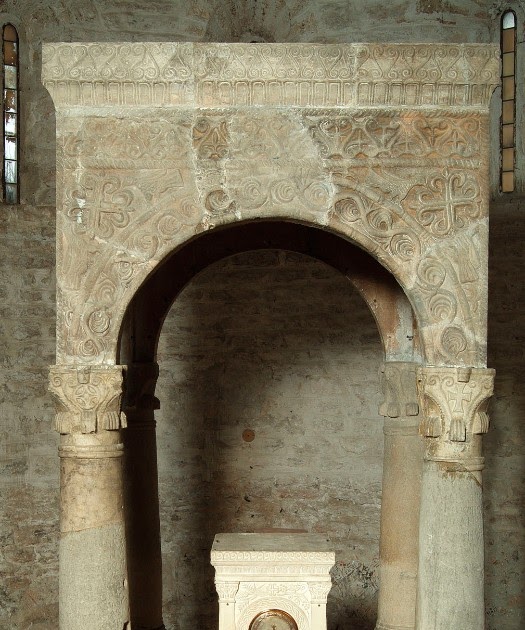- Feb 5, 2002
- 166,654
- 56,276
- Country
- United States
- Faith
- Catholic
- Marital Status
- Married
- Politics
- US-Others
Early ciboria are not always easily found but today we have one to share with our readers that has been dated to circa A.D. 700-750. We have mentioned here before in our series on the history of the forms of the Christian altar that in their earliest incarnations, altars were much smaller and more cube shaped. This might seem impractical but at this point of liturgical history nothing was placed upon them except what was required -- namely the bread and the wine to be consecrated. Altar lights came in the form of hanging lampada (sometimes hung from the ciborium itself) and coronae, or as standards set near the altar and sanctuary as opposed to being placed on the altar itself as we are now accustomed to.
The display shown here above intends to approximate an early form of altar placed within the context of the ciborium to help people to better understand the relationship and proportions. Of course, a picture is worth a thousand words, so to this we'd add this medieval illumination that shows priest at an early, cube shaped altar covered with its ciborium. To round out this historical picture, it must be mentioned that early ciboria also frequently had curtains in order to veil the sacred mysteries during the holiest part of the liturgy: the Eucharistic Canon. An example of such a usage can be seen here in this drawing (see right) based upon one of the early mosaics found in the church of St. George in Thessaloniki.
Continued below.

 www.liturgicalartsjournal.com
www.liturgicalartsjournal.com
The display shown here above intends to approximate an early form of altar placed within the context of the ciborium to help people to better understand the relationship and proportions. Of course, a picture is worth a thousand words, so to this we'd add this medieval illumination that shows priest at an early, cube shaped altar covered with its ciborium. To round out this historical picture, it must be mentioned that early ciboria also frequently had curtains in order to veil the sacred mysteries during the holiest part of the liturgy: the Eucharistic Canon. An example of such a usage can be seen here in this drawing (see right) based upon one of the early mosaics found in the church of St. George in Thessaloniki.
Continued below.

An Eighth Century Ciborium
Catholic liturgical art, vestments, sacred architecture, sacred art, sacred music, liturgical books
